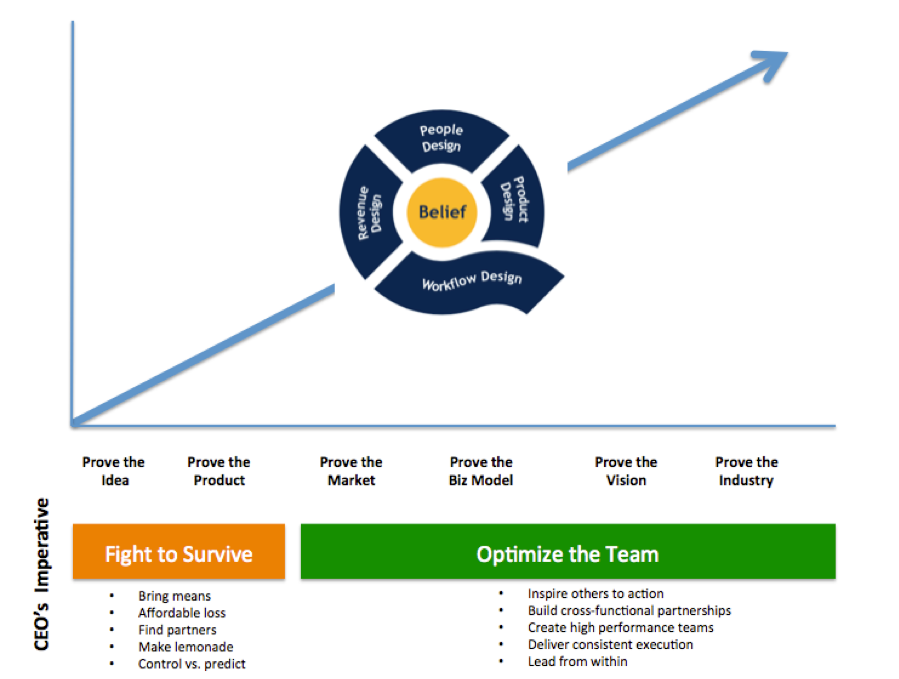In Defense of the Founding CEO
Consider this a call to arms.
Founding tech CEOs are in peril. The risk to their jobs growing steadily as they scale. Given all they have given, the fact that so many founding CEOs falter is tragic. How can we help these startup heads hold the helm as they lead their companies from stage to stage on the path towards greatness? Is there a model that founding CEOs can adopt to adapt? The answer is yes. This is that model’s manifesto.
Of the 60,000 software and internet companies funded in the past 10 years, just 0.14% have market valuations over $1 billion. Instructively, 74% of these are still led by their founding CEOs [1]. Another recent analysis showed that over 20 years, 900 companies and 1,200 financings from 1994–2014, the difference between capital raised and company valuation was 50% less if a founding CEO was replaced, vs. where the founding CEO was retained [2].
“The Best Founding CEOs Survive and Thrive”
What can we learn from this data? The best founding CEOs survive and thrive. They are riddle crackers. They have continuously adjusted their approach to leadership so as to successfully detect, define, prioritize and crack the key riddles they have faced at each stage of growth.
Health care, education, household purchasing, social experiences, B2B decision analytics, business workflows and more have been transformed by the work of founding CEOs. The best have visited creative destruction on old systems, structures and companies. Leveraging big data, infinite computing, sensing networks, artificial intelligence, 3D printing, digital medicine, robotics and other innovations, these CEOs have stripped down and rebuilt human activity after human activity, sector after sector. But many who started the journey didn’t stay to see it through.
It is a sad fact that 54% of VC-backed companies replace founding CEOs [3]. These replaced founders were the value creators. It was by their sweat that their companies were willed into fundable existence. These departed CEOs relinquished their roles due not to founder-unfriendly VCs, but rather to their inability to conform their leadership to the task at key company growth points. For some, exiting the CEO role was inevitable and appropriate. For too many, this fate was avoidable. It is on behalf of these CEOs — the ones who possessed the innate competencies to make it, but failed to gain the necessary self-awareness and pattern recognition — that this manifesto is dedicated.
“Leadership is about Leverage”
Leadership is about leverage. Effective CEOs leverage their teams to accomplish great things. Great things are accomplished when the right riddles are cracked. And so it goes that a CEO’s riddle-cracking proficiency determines the success of the company. It’s as simple, and as hard, as that.
The model anchoring this manifesto provides you, the founding CEO, the framework you need to become an adaptive, riddle-cracking leader. Here it is:

As CEO, you are the riddle cracker. In the early going, the overarching riddle is deadly simple: prove product / market fit before the money runs out. As a company scales, the riddles become more complex — just as resources become more plentiful. Tien Tzuo, CEO of Zuora, has identified six stages of scaling, corresponding to six riddle stages [4]:
- $0M — $1M: Prove the idea
- $1M — $3M: Prove the product
- $3M — $10M: Prove the market
- $10M — $30M: Prove the business model
- $30M — $100M: Prove the vision
- $100M — $300M: Prove the industry
Underneath each of these riddle stages are specific riddles. For instance, under “prove the idea” might be to achieve a customer count of 100 or MRR threshold of $50K or an ROI-positive free-to-paid conversion percentage.
Under “prove the business model” it might be to achieve 75%+ gross margins or to reduce annual churn to below 10% or to design the org chart, staffing and training to maximize the efficiency of key workflows. Under “prove the vision” there might be the need to introduce and successfully scale and monetize key product extensions that fill out the product vision.
As the riddles change, so does the requisite leadership approach. In the “fight for survival” stage, Saras Sarasvathy of the University of Virginia has identified five attributes exhibited by expert entrepreneurs [5]:
Bring Means
- What we know
- Who we know
- What we have
Affordable Loss Orientation
- Primary focus on limiting risk
- Manage investment based on amount that can be affordably lost
- Less focus on potential upside
Make Lemonade
- What can we learn from everything we do
- How do failures inform us
- Build / Measure / Learn
Build Partnerships
- Attract partners early and often
- Every partner co-creates the future with the entrepreneur, bringing new knowledge, contacts and money to the enterprise
Control vs. Predict
- Don’t spend time trying to predict the future
- Control the accessible levers
- Learn and adjust
Notice that the defining characteristic of these attributes is that they are a response to constraint. Scarcity drives the need for means, the focus on risk mitigation, the need for rapid iteration, the desire for partnerships and the bias towards control. In an early-stage startup the CEO is standing in a lifeboat, oars in hand, searching for sight of land before the food and water are gone. A small team paddles furiously with her, but’s it’s the CEO that takes control, seeks to reduce risk, and scrambles for traction.
The Shift from Survival Focus to Team Focus
As a company proves traction, however, that traction begets investment. As resources become more ample, the team expands — the product extends — the customer count grows — the workflows formalize and diversify. The gap between the front-line employee and the CEO widens as mid-management layers are introduced into the hierarchy. As a result, the riddles become more complex — as does the CEO’s role. Here, success increasingly depends on leveraging the team.
Let’s go back to Tien Tzuo at Zuora. Zuora is now a $1B+ value company. Recognizing the shift, Tien has recently challenged his leaders to adopt five key leadership principles:
- Inspire Others to Action
- Create High Performance Teams
- Build Cross-Functional Partnerships
- Deliver Consistent Execution
- Lead from Within
Notice the difference? Whereas in the early going everything is bounded by scarcity and executed via strong CEO control, now everything is bounded by team effectiveness and executed via smart deployment and empowerment. The leadership question has become “how can I elevate the performance of people throughout the company to accomplish great things?” vs. “how can I accomplish great things?”. This is a profound shift in the required leadership approach. Many CEOs fail to make the shift.
Of course, this is just the beginning. It’s not enough to just understand the riddle stages, nor how your leadership approach must change as you “level up” from scarce to ample resources. Knowing the riddle stages and appreciating the required change in leadership approach will help you to detect, define and prioritize riddles: but you still need to crack them.
In Part 2, founding CEOs will learn about the solution toolkit they can draw upon to effectively and successfully crack the right riddles
[1] Aileen Lee, “Welcome to the Unicorn Club, 2015: Learning from Billion Dollar Startups” (July 18, 2015, techcrunch.com)
[2] Ben Narasin and Mike Abbott, “The Importance of Founders” (May 11, 2015, techcrunch.com)
[3] Anna Johnson, “Do VCs Usually Fire Founder CEOs?” (Oct 5, 2010, kikabink.com)
[4] Index Ventures: “Climbing the Mountain: What Zuora CEO Tien Tzuo Thinks About when Scaling a Company” (http://indexventures.com/news-room/index-insight/climbing-the-mountain-what-zuora-ceo-tien-tzuo-thinks-about-when-scaling-a)
[5] Saras Sarasvathy, University of Virginia, Effectuation Research
https://medium.com/ceoquest/chapter-1-revenue-engine-overview-bd7047a57b3#.m9b8jpt0f

